What types of linkable assets work best?
There are many.
You have to choose the right type of linkable asset for your business and then market it religiously. That’s how it’ll get links naturally.
The publish-and-forget method doesn’t work.
No matter how great your asset is.
This guide explores the best types of linkable assets and how to create and market them.
What is a Linkable Asset?
A linkable asset is an asset (usually content) that attracts backlinks naturally. The content is created to acquire links and improve your site’s overall rankings.
Backlinks, as we know, are the most important Google ranking factor with the highest weightage. They are absolutely essential to outrank your competitors in SERPs.
However, it’s not easy to get backlinks.
Linkable assets make it easy.
Why?
Because these assets are highly informative and well-researched. They attract backlinks naturally.
Not all linkable assets get backlinks. In order to get links for your content, you need to make sure:
- The content targets informative keywords (not commercial or transactional)
- The asset must be non-imitable or very hard to imitate. If it’s easy to imitate, others might copy it instead of linking to it
- The content must cover all aspects of the topic. It should leave no room for improvement.
Here’s an example of a listicle post that has attracted 334 backlinks from 100 referring domains:


The article targets information search intent, it is fairly non-imitable as it’ll require a lot of time and effort to do a better article than this, and the article covers all the aspects of gardening tips and ideas.
Linkable Assets Need Promotion
Here’s the catch: Most marketers think that creating a linkable asset is all they need and it will start attracting backlinks on its own.
No.
It doesn’t happen.
You need to promote the linkable asset and share it with relevant people who are likely to link to it. Such as bloggers and influencers in the same niche.
If left unattended, linkable assets – no matter how awesome they are – won’t generate any traction.
You might argue that what’s the point of spending tons of resources on creating a linkable asset if it has to be promoted?
Linkable assets are more likely to get backlinks than any other content piece. You need to create these pieces in a way that when you share them with someone, they can’t say no.
Once you get a few initial backlinks, it keeps generating backlinks on its own as it hits the first page.
Why?
Because people can’t resist linking to it.
That’s how a linkable asset works.
If you are ready to spend time and resources in creating and marketing amazing content, keep reading to find out the different types of linkable assets.
Type of Linkable Assets
Here’s a list of the popular linkable assets that’ll make it easy to acquire backlinks and improve your site’s rankings and organic traffic:
1. Online Tools
Online tools and HTML calculators are perfect forms of linkable assets that genuinely attract natural backlinks.
These tools can range from a free calculator to a blog outline creator to a calorie counter or anything that provides an instant solution to your target audience.
Here’s an example of a BMI calculator:
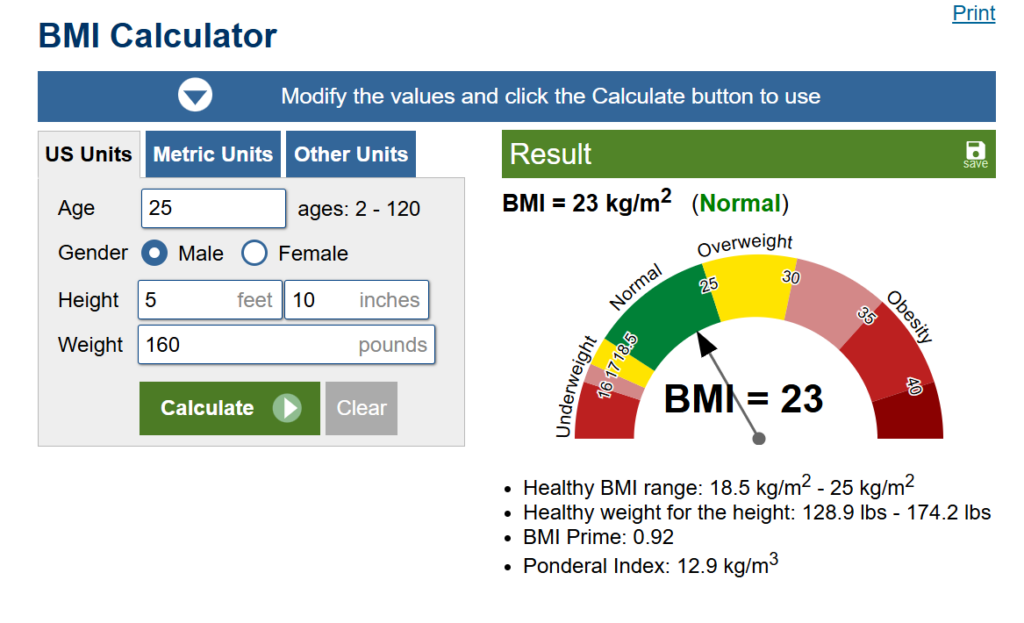
This calculator has received 6,000 backlinks from 975 referring domains:
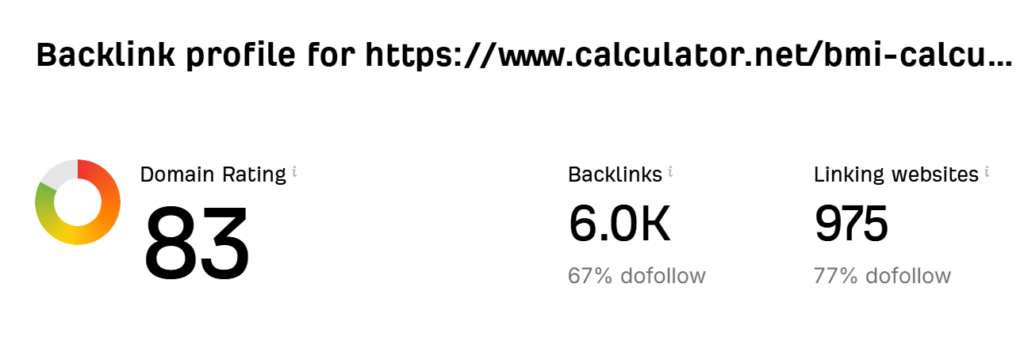
These online tools are all over the internet and used extensively by end-users.
The good thing about an online tool is that it doesn’t cost you a lot to create one.
For instance, the above BMI calculator is developed in HTML and it doesn’t cost you more than $500 to create a similar tool. Head over to Fiverr or Upwork and you’ll find tons of sellers who are selling these calculators at a fairly reasonable price.
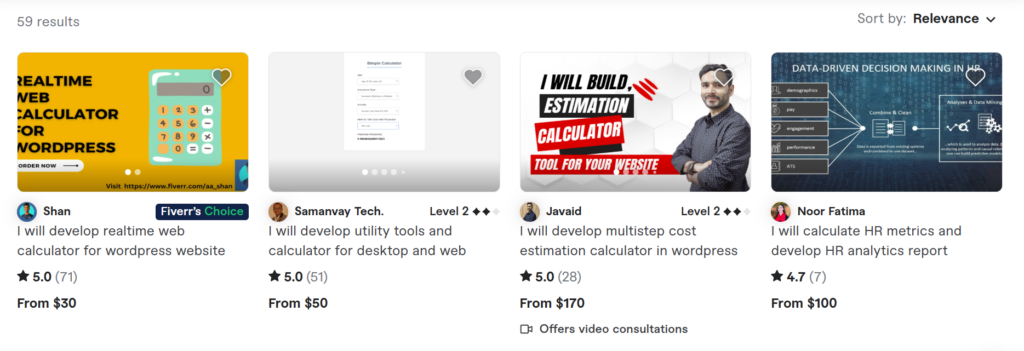
If you compare the cost of development to the value of backlinks, the difference is gigantic. It pays off big time.
You need to have a solid useful online calculator that solves a real problem. Your tool should have the following characteristics:
- Highly useful and easy to use
- Exceptional accuracy
- Must target a broad keyword with a high monthly search volume
- The target keyword or calculator should be evergreen – not seasonal.
Once your tool checks all of the above, the next big task is promoting it.
Yes, you need to religiously market your online tool to get backlinks. Creation and publication won’t work.
Here’s how to market your online tool:
Outreach
It’s the best way to promote your online calculator.
Find sites and people who have already published similar content or have linked to similar resources.
For instance, if you create a BMI calculator, you need to look for articles about BMI guides, BMI calculation methods, what is BMI, etc.
Reach out to these bloggers and send them a link to your BMI calculator. Since they have already published content on the topic, linking to your free calculator will add more value to their content.
They lose nothing.
Outreach is the best way to get initial backlinks for your online tool.
Internal Linking
If your domain has a high authority, you can pass link juice from the homepage and other key pages on your site by linking to the online calculator.
This is an instant way to improve your tool’s ranking. Once it reaches page one on Google, it’ll start getting backlinks naturally (if it’s really amazing).
If you have a large audience, consider using the following methods to promote your tool free of cost:
- Send a link to your list in the email newsletter
- Share online tool on social media accounts with your existing followers
- Publish content and guides relevant to your online tool so you can promote it.
Online Ads
If your domain has low authority and you have a relatively new business, it might get very tough to get backlinks via outreach.
Established websites with high DA and DR usually don’t link to sites with low authority – even if you have an awesome online tool.
It’s, unfortunately, true.
In this case, you might have to get initial traction by running PPC ads, especially Google search ads.
Instead of targeting users, target influencers and bloggers who are more likely to link to your tool.
Yes, you can target end-users too – but it might not get you backlinks.
Find an ad network with low cost and run highly targeted ads to reach specific influencers. This is an ideal way to connect with the right people.
2. Infographics
Brian Dean used a technique called “guestographic” to promote an infographic he created. He increased organic traffic to the site by 175% and acquired backlinks from several high DR sites at potentially zero cost:

Here’s how this technique works:
- Create an infographic on an evergreen interesting topic
- Publish it on your site
- Outreach to relevant blogs and sites and request them to republish your infographic on their site
- Offer them unique content that they can publish with the infographic.
What makes infographics a linkable asset is that infographics are hard to create as they require resources. It’s a costly asset to imitate.
This is the reason why people prefer linking to an infographic instead of recreating one.
The catch is that you need to send unique content with your pitch. Here’s an example outline email you can use for the Guestographic method:

This strategy has two key steps that you need to follow religiously to make it work:
Infographic Creation
The infographic should be something more than ‘ordinary’. It has to be epic.
It should be highly informative and well-researched.
And, it must make readers ‘wow’.
Check out this interactive infographic on how a car engine works. It is the type of infographic you can’t recreate easily and it is highly informative.
If your infographic doesn’t deliver an exceptional UX and stand out from the crowd, it won’t get backlinks. In fact, such an infographic won’t be considered as a linkable asset.
An epic infographic requires one of the two things:
- It should be data-driven and highly informative
- It needs to be interactive – instead of plain images or graphics.
If you can incorporate both in a single infographic, it’s best.
Initially, stick with one and see how it works for you.
Infographic Promotion
Once your infographic goes live, you need to promote it and get backlinks.
Here are some of the best ways to market your infographic for backlinks:
- Manual outreach with an offer to write unique content
- Reach out to sites that have already linked to similar content or infographics and offer them your infographic. In this case, it has to be better than the one they are already linking to
- Publish your infographic on directories and image-sharing sites
- Share snippets of your infographic on social media and image sharing sites
- Publish it on niche forums and relevant platforms such as Quora and Reddit.
3. Coin a Term
It’s a bit challenging, but coining a term can turn the tables for your business.
Once your coined term gets popular, you’ll get tons of backlinks – forever.
It’s quite challenging though.
A new term needs to be promoted a lot so others can start using it. This needs time, patience, and consistency. It won’t happen quickly.
For instance, the term ‘10x content’ was coined by Rand Fishkin which has gained a lot of popularity over the years and the page received 1.4K backlinks from 596 domains. The most used anchor text is ‘10x content’ which has pushed the Moz to the first place in SERPs:

The term received instant hype and was popular fairly quickly for a couple of reasons:
- Rand Fishkin was already popular and followed by marketers and SEO professionals
- Moz is one of the most visited sites and it has high domain authority.
If you or your brand are popular already with a decent following, the term you coin will kick off instantly.
However, it might never work for you if you or your business are unknown and new.
If you are relatively unknown in your niche, it isn’t a good idea to coin a term as it will require a lot of marketing (we’ll get to that shortly). If you can do it, great.
Else, you should consider using other types of linkable assets.
You need to understand that it’s not the coined term that gets popular, it’s the person or brand who coined the term. You should be considered an expert in the niche.
For instance, if Elon Musk coins a new term in the electric vehicle niche, it’ll instantly get noticed. All the leading journalists, news channels, magazines, blogs, and influencers will start quoting and using the term.
If someone who runs a blog on electric vehicles coins a new term, it might not receive the same reception.
You get the point – right?
Once you have done the basics and coined the term, the real challenge begins – promoting it to get backlinks.
Share with Your Existing Audience
The best way to market a new term is by sharing it with your target audience and followers. This will give you an instant boost.
The more people know and use your term, the more quickly you’ll get backlinks.
Share the new term with your list, customers, social media followers, business partners, and across all the channels and touchpoints.
Don’t restrict yourself to your audience rather expand vertically.
Share it with your suppliers, business partners, agencies you work with, etc.
You need to make sure people know the term you coined, its meaning, and its philosophy. That’s the only way they’ll use it.
Once you get the word out, activate alerts for the term so that you get notified whenever someone mentions the term online. When you receive an alert, do the following:
- Engage with them on the platform
- Convert unlinked mentions into backlinks by requesting a link
- Explain your term in detail and answer queries.
Guest Post
You should get the word out by publishing guest posts on authority sites. This will help you in two major ways:
- You can generate contextual backlinks
- The coined term reaches a relevant audience.
You should target blogs that receive massive traffic. Don’t focus on DR, DA, or other metrics. The only metric you should look for is traffic (from any source).
This is because the idea is to reach a wide audience and spread the word about your coined term.
The purpose of guest posts shouldn’t be to get backlinks, rather they should be aimed at awareness. Backlinks will follow naturally.
Outreach
Manual outreach is another effective way to promote your coined term and get relevant backlinks.
This might get tricky as people don’t tend to link to new, unknown terms. You need to find influencers in your niche who have linked to similar content that matches your coined term. Reach out to them and share details of your coined term.
Here’s a template you can use:
Subject: Hey [First Name]!
Hey [First Name],
I saw your post on [Topic], and noticed that you’ve linked to or mentioned [competitors’ name and topic].
I thought this piece on [the topic of your content, and how it differs from your competitor’s] I recently published is more relevant and updated.
Just to let you know that I have coined a term [term name] that reflects [details of the term].
[insert link to your content]
[Your Name]
The outreach email should explain:
- The coined term
- Why it was necessary
- How linking to it or mentioning it can help their blog and audience.
4. Research Studies
Nothing beats original research and whitepapers. These are the best types of linkable assets as they are extremely valuable.
And a research study is almost impossible to imitate.
Here’s an example:

It was published by Ahrefs and they analyzed 2 million featured snippets. It’s almost impossible to imitate this study. You can’t analyze 2 million featured snippets unless you have resources which Ahrefs already has.
This study has over 2.5K backlinks from 1.4K domains with 90+ DR sites linking to the study.
If you can create this type of research study, you can get a lot of backlinks.
The best way to create studies is by utilizing the data you have.
For instance, Wyzowl publishes video marketing statistics yearly by surveying its users. It has garnered 29K backlinks from 10K domains which is a massive success:

Here are a few ideas to help you create research studies that provide your business with a competitive edge:
- Leverage existing data that you have
- Collect primary data specifically for a study (e.g., survey or interviews)
- Address a common problem in your niche scientifically
- Collaborate with researchers and subject matter experts to publish original scientific research studies.
Follow these additional guidelines to make your research study worth linking:
- Use graphics and charts for easy sharing and understanding
- Make your study easy to read. Avoid using scientific and statistical terms
- Publish it frequently (e.g., yearly) to retain and grow your audience.
Probably the best thing about research studies is that they are extremely easy to generate backlinks. This doesn’t mean you don’t have to promote them.
Here’s how you can promote your study to get backlinks quickly:
Optimize It
Since a research study offers valuable, data-rich content, you need to optimize it for SERPs. Target a specific keyword, implement on-page SEO, and acquire backlinks (more on this below) to improve its ranking.
Here’s an example by Ahrefs where it ranks in first place in Google for a competitive keyword. The article is a research study based on a survey they conducted:
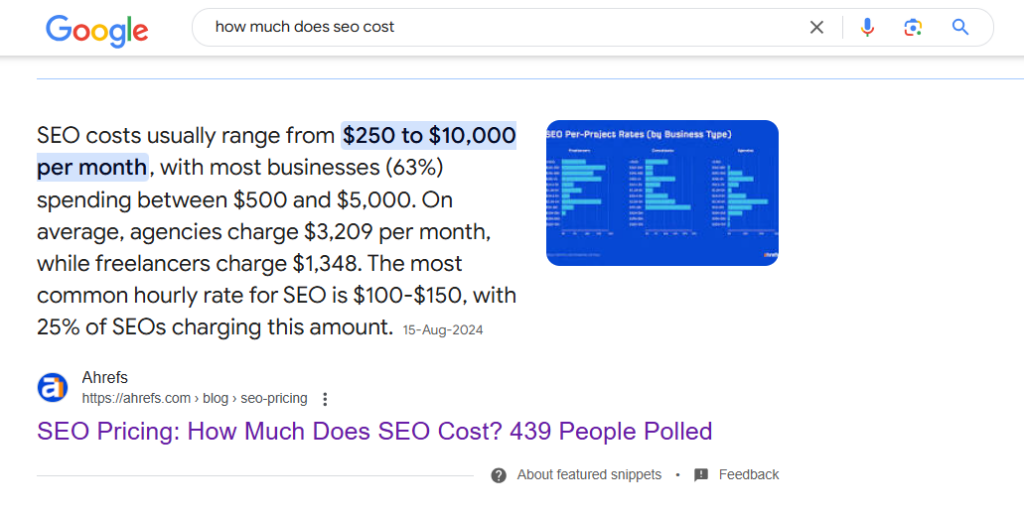
Check out how these have optimized the title and entire article for highly competitive keywords like SEO pricing and SEO cost:

Consequently, they are ranking on the first page and have gained more than 9K backlinks.
SEO works for research studies.
Don’t ignore it.
Outreach for Backlinks
It is quite easy to get backlinks to a research study. You just need to show your study to relevant people.
These include people who have:
- Linked to similar content
- Talks and publishes content in the same niche.
A simple email that gives them an overview of your study and a few key findings is all you need to do to entice them to share your study with their audience and link to it.
5. In-Depth Guides
This is the easiest and most cost-effective way to create a linkable asset.
Detailed, in-depth guides and tutorials that cover the topic comprehensively acquire backlinks naturally. Your guide ranks for multiple keywords as these guides are much longer than normal articles.
This HTML Tutorial by W3Schools has more than 1 million backlinks.
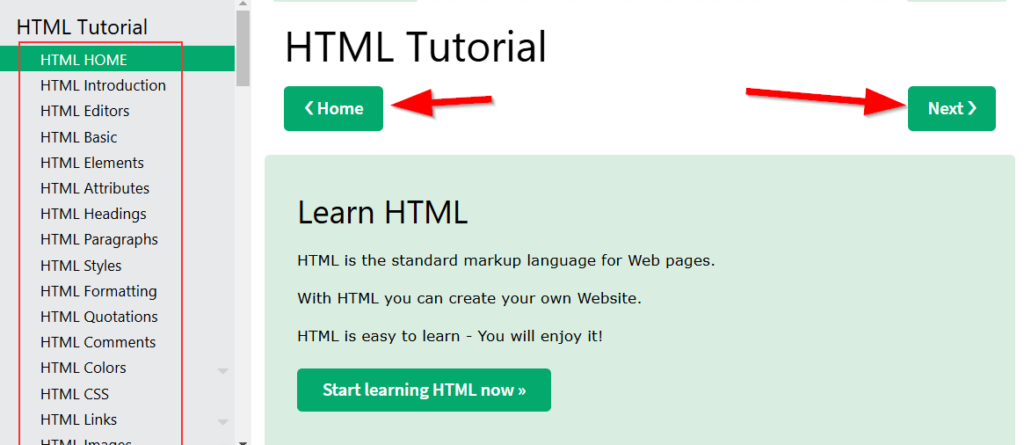
They have an insanely comprehensive and interactive tutorial that includes examples, quizzes, videos, and exercises. It spans several pages. It’s a mini website on HTML.
This is the reason they have more than a million backlinks – amazing.
A guide like this can help you earn a lot of backlinks.
You have two options to choose from when creating an in-depth guide on a topic:
- If you have the resources and budget, go with a very detailed guide (like W3Schools). It won’t be easy to create but such a linkable asset will do wonders for your site
- Write simple, basic definitive guides if you have high domain authority. In this case, your guide should be more detailed and in-depth than existing guides.
In either case, you have to rigorously promote your guide.
And you have to refresh it regularly.
Why?
Because there are a lot of guides in pretty much every niche out there.
While guides are easy to create, they are highly competitive – and hard to promote.
PPC
A smart way to market your detailed guide is by running paid ads.
You can use social media ads and Google search ads to promote your guide.
You don’t have to do it for the sake of driving traffic, but for backlinks. Target people who are likely to link to your guide.
This is a technique used by a lot of leading businesses such as Zapier and Semruh where they run Google search ads for articles.
Guest Post
You can promote guides by publishing guest posts on relevant blogs. This helps you get contextual links.
Once you start building links to your guide, it will improve its ranking.
The idea is to make it visible in SERPs so people can find and link to it.
Sending outreach emails for a definitive guide might not help you land backlinks unless your guide is one of a kind (which is quite unlikely).
Your best bet is to publish quality guest posts to promote your guide.
Bonus Types of Linkable Assets
Here are a few more linkable assets you can try:
- Tutorials
- Statistics articles
- Free resources
- Listicles
- Awards.
Final Words
The types of linkable assets you create for your business depend on your business and marketing strategy. The above list is to give you ideas.
You don’t have to create all types of linkable assets necessarily.
Choose one type and see how it works.
Remember, publishing isn’t enough. You have to spend more time and resources in marketing your likable asset. That’s how you get backlinks.
Featured Image: Pexels



